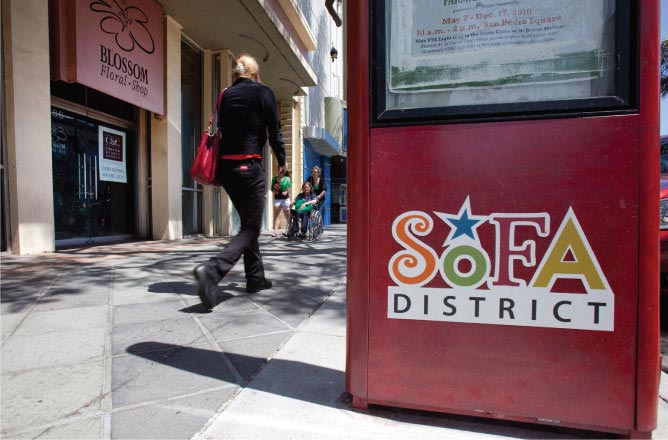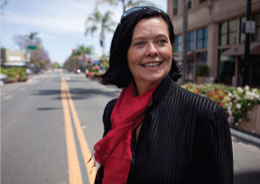Video
“1st Act San Jose” on Vimeo
They set out to create a sense of place in a major American city that lacks a soul. Civic leaders in San Jose, Calif., observed the chasm between the geniuses of Silicon Valley and “the flatness of how we look and feel,” as one described it, and were convinced they could change it.
Their vehicle: 1stACT Silicon Valley, initially a network of volunteers directed by the charismatic Connie Martinez and later backed by funds from the John S. and James L. Knight Foundation. With support from several of the Valley’s high-tech leaders, 1stACT re-imagined San Jose as a vibrant urban center and cultural magnet.
“The way things happen in this valley is through networks,” said Martinez, a longtime civic player, describing her approach. “We’re very Web-like.” That works to her advantage because Martinez is as connected as an adolescent on Facebook.
Along with her supporters, 1stACT chiseled a bold vision into its strategic plan: make San Jose a destination with a cultural identity “equal to the richness of our diversity and global leadership in technology and innovation.”
Nearly three years later, true to its name, 1stACT is just mounting its production, nowhere near reaching its aspirational destination. Despite absorbing the wallop of the global economic crisis, Martinez and her staff of charming go-getters entered the trenches, renovating a bleak downtown neighborhood known as South of First Area in a pilot project for other districts to emulate. Or not.
With twinkling lights and blooming geraniums, SoFA looks a lot better, and artsy crowds gather there for special events. But the rest of the time it’s mostly an empty place. During the day, “you could shoot a cannonball down the street and not hit anyone,” said one city councilman. Supporters say this will change with the economy, but critics say there was too much emphasis on making cosmetic improvements and not enough on luring anchor tenants. “Tarting up a place,” one civic leader said, isn’t the way to create a destination.
Beyond SoFA, 1stACT trained multicultural arts leaders and provided seed funding for live music and digital arts projects, offerings Martinez says resonate in Silicon Valley. Martinez says 1stACT has also provided the impetus and garnered support from community leaders for several civic and cultural ideas, such as a creative center for the arts, iconic public art projects and a grand downtown park. Next, she plans to look for funding.
While 1stACT’s changes may not yet be all the group had envisioned, Martinez and company have changed the city’s conversation about itself. Leaders now talk about developing San Jose as the region’s urban hub. City plans emphasize the importance of aesthetics and a sense of place. They didn’t before.
And in Martinez, the community has gained a leader who’s corralling disparate civic groups, public officials and the philanthropic community to unite behind a common cause. “Connie is pushing people to think bigger or more creatively,” said Dan Fenton, CEO of the San Jose Visitors and Convention Bureau. “She’s saying, ‘Isn’t there a better way to differentiate us?’”

A pedestrian walks by a sign in the SoFA district, a once bleak stretch of downtown San Jose recently renovated with funding from 1stACT Silicon Valley and the San Jose Redevelopment Agency. Its a brighter, livelier and more pedestrian-friendly place that draws caf crowds and gallery hoppers. But its still emerging as a viable arts and entertainment district.
SCENE ONE
Only a few decades ago, San Jose was embroidered with plum and apricot orchards. Today it’s the 10th largest city in the nation, home to the NHL’s Sharks and southern anchor of the Bay Area. But San Jose’s small and soulless downtown pales in contrast to San Francisco, and few think of it as Silicon Valley’s urban core. For goat cheese salad, Monet and Manet, world-class opera and ballet, even for street cart crème brulée, locals drive north to San Francisco, the place they simply call “The City.”
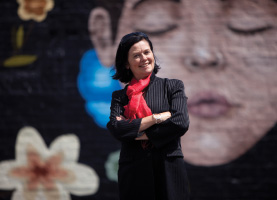
Connie Martinez, CEO of 1stACT Silicon Valley, stands in front of one the murals her group commissioned. Next she wants to raise $25 million for projects that may include an urban park, public art, office-gallery space, childrens arts programs and a marketing campaign.
The region’s world-class workers report to insular campuses in suburbs like Sunnyvale and Cupertino, connected by tech work and families, but not so much by a sense of place. Instead of a cluster of high-rises developing in downtown San Jose, the Valley became home to a “bunch of buildings with logos,” said Bruce Chizen, former CEO of Adobe and 1stACT chairman emeritus. Slow to develop in San Jose are the classic attractants of a big city: a thriving street life, arts and culture, great public spaces.
The gap between the talent pool and the city’s lackluster looks and offerings concerns local leaders. It’s enough to give a city an “inferiority complex,” said San Jose city councilman Sam Liccardo.
Worse, some leaders believe the gap between the creativity of the work force and the blandness of the landscape could have an economic impact.
“In order to be the best in the world, you have to have the best, brightest and most creative employees in the world,” Chizen said. “The only way that you are going to continue to attract and keep employees in the Valley is by having a great vibrant community with lots of [cultural] stimuli.”
But creating a sense of place is a large and complex undertaking. “It’s about revitalizing neighborhoods,” said Peter Calthorpe, author of The Next American Metropolis and The Regional City. And getting the big things right: A city must have “a healthy balance of uses,” such as shops, housing, jobs and a diverse population. It needs “places that attend to pedestrians” and sidewalks big enough for cafes. Place making, he said, includes “catalytic institutions,” such as art museums and performing arts districts “sitting on top of a healthy framework. If you don’t get the framework right,” he said, “it doesn’t matter how much you put on top. It won’t work.
“Much of San Jose’s downtown has the right stuff,” Calthorpe said. “It may be it just needs to get kicked to the next level.”
It’s an audacious task, amounting to changing both appearance and perceptions. Leading the charge, beginning as early as 2003, has been Martinez, previously planning director for the community of Mountain View and executive director of the Children’s Discovery Museum of San Jose, where she took an organization run like a family and imbued it with structure, greater meaning and respect. For years, she has also been a member of the American Leadership Forum, a chummy brotherhood of Silicon Valley people in high places.
Harnessing longtime friendships and alliances, Martinez has at her side the sovereigns of Silicon Valley: leaders of Adobe, Cisco Systems and Applied Materials, (although not the rock stars of Google or Apple), all of whom share her desire to add texture to the physical and cultural landscape.
To push the agenda, in the summer of 2006, Martinez enlisted then Knight Ridder CEO Tony Ridder and Adobe’s Chizen to accompany her to what would be prescient meetings with San Jose’s mayoral candidates, seeking their support for a vibrant new vision for downtown. It worked.
In January, 2007, when San Jose Mayor Chuck Reed gave his inaugural address, he spoke these simple words:
A great city has a great downtown that is economically strong and vibrant with arts, culture and entertainment.
And he made Martinez the master of ceremonies.
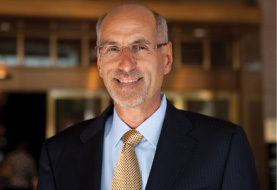
Bruce Chizen, former CEO of Abobe Systems and 1stACT’s chairman emeritus, sees an economic upside to 1stACT’s agenda. Silicon Valley needs a vibrant urban core and lots of cultural stimuli to retain its world-class work force, he says..
The city manager and the city council endorsed 1stACT’s concepts. The redevelopment agency earmarked $5 million for 1stACT’s strategies to improve downtown. Martinez was on a roll.
But civic messages don’t always wash over every bureaucrat’s cubicle. Knowing that, Martinez & Company spent months going door to door to 87 organizations and 3,000 people, from neighborhood groups to the chamber of commerce, peddling their vision for downtown.
Until 1stACT came along, “we were whirling around, bouncing from tactic to tactic,” said Scott Knies, executive director of the San Jose Downtown Association, one of 1stACT’s most vocal allies. 1stACT, he said, pulled them out of “the weeds” and made them look “at the 10,000-foot view.”
That view: Silicon Valley needs a creative urban center, a physical manifestation of its innovation and creativity,” he said.
In October 2007, Martinez and 1stACT received a three-year, $3.5 million matching grant from Knight Foundation to support their efforts. “Based on a 2009 national study we commissioned from Gallup, called Soul of the Community, we know that people feel more attached to a place that is physically beautiful, has opportunities for socializing and is open to a diverse range of people,” said Paula Ellis, Knight Foundation’s vice president for strategic initiatives. “We want to help make San Jose a destination for people to live, work and play.”
The grant spelled out Martinez’s plan to find another $3.5 million in cash, nurture emerging multicultural arts leaders, increase financial support for arts and culture and “transform San Jose’s cityscape to an active network of public spaces with a sense of arrival and destination.” 1stACT told Knight the initiatives would raise community self-esteem, foster cultural connections, enhance livability and help Silicon Valley lure and retain “the world’s most creative people.”
1stACT’s objectives, even in good times, sounded to some observers as more aspirational than doable.
“1stACT was launching its canoe into an incoming tsunami, the worst recession in three-quarters of a century,” said city council member Liccardo.
The anticipated millions did not flow. Local foundations were more inclined to keep alive current initiatives than to fund new ones, and “they wanted to see traction,” Chizen said. Although the Knight grant required 1stACT to find matching funds, Martinez took a longer view: “We were not ready until we created the ideas worth investing in.”
1stACT was able to raise $795,000 in cash from private sources and $1.2 million in cash from the redevelopment agency. It met the rest of its fund-raising obligation to Knight by substituting in-kind services worth approximately $1.6 million.
SCENE TWO
1stACT’s signature project is South of First Area (SoFA) in downtown San Jose, a scruffy stretch of art galleries, restaurants, nightclubs and vacant storefronts. It was designed to demonstrate 1stACT’s core principles: creating a destination, showcasing Silicon Valley innovation and diversity and making streets pedestrian friendly. It’s where, Martinez says, “we got our hands dirty.” And if it worked, she imagined, “it would spill over into new ways of looking at the rest of downtown.” It is 1stACT’s most ambitious project, with $1.7 million in private and public money spent so far.
Initially, locals “were cynical,” said Ben Soriano, who owns South First Billiards in SoFA, which doubles as an art gallery. 1stACT’s “optimism and positive attitude,” he said, “was a huge change for us.”
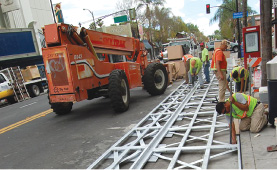
Workers install sidewalk extensions to create space for planters and outdoor cafs. Bringing people outside and creating places for them to connect are among the design principles 1stACT advocates for downtown San Jose.
With $275,00 of its Knight money, 1stACT brought in Ken Kay, a San Francisco urban designer and landscape architect, who listened to people’s desires and developed plans to narrow streets, widen sidewalks for cafs and add planters, flowers, festoon lighting, bike racks, banners and a gateway to mark the entrance of SoFA. Kay called it a “paradigm shift” that took three years to negotiate “and three weeks to build.”
Widening sidewalks required buy-in from the transportation, fire, planning and cultural affairs departments. Before wrapping tiny lights around palm trees, 1stACT staff needed to find a power source, resolve the payment structure for electricity and win approval from the department of transportation. When Erika Justis, 1stACT’s director of Creative Place, wanted to add plants, officials warned that homeless people would throw up on them.
“I don’t think we quite knew what we were getting into,” Justis said. “I don’t think we understood how many people had to be involved [and] how much time it would take to get all those people on board.”
Along the way, 1stACT began chipping away at the city’s mindset and changing its laws. 1stACT’s staff attacked obstructionist ordinances that made it illegal for coffee carts to be on the street before 10 a.m. or for street vendors to cluster. When they encountered a byzantine process for granting outdoor caf permits, 1stACT set about untangling it. With city strategist Kim Walesh, who says she has the wounds to prove it, they cut the police department out of the mix and simplified procedures. The redevelopment agency assigned a staffer to hold the hand of merchants seeking outdoor caf permits.
“1stACT galvanized the politicians to say ‘clean up the rules so an average human being can expect to [acquire an outdoor caf permit] in a lifetime,’” said Bill Ekern, the redevelopment agency’s director of project management.
SCENE THREE
By June 2009, SoFA looked a lot better. On weekends, neighborhood restaurants Caffe Trieste and Original Joe’s now bustle with customers who sit al fresco on new sidewalk extensions. And The Agenda Restaurant (with an excellent but oxymoronic menu of healthy Southern cooking) is doing something innovative: it’s open for lunch.

Caffe Trieste, one of San Francisco’s most venerable restaurants, added an outdoor caf to its SoFA location after 1stACT spruced up the area.
One night a month, on South First Friday, SoFA comes alive with gallery crawlers. A man wearing spats cycles around on an antique bike, a transvestite discos on a platform inside an art studio. Opera lovers attend Puccini’s La Rondine, while across the way a karaoke ice cream truck lures sweet-toothed singers.
Gallery owner Brian Eder, who started South First Friday in 2000, said 1stACT helped the monthly event expand into the street.
“I’ve been here since 1972,” he said, and until recently “no one was talking about the art scene here. In the last three to five years people sense something different is going on. I believe 1stACT is part of that.”
With $100,000, 1stACT solicited bids and is funding 14 mini-projects in SoFA, such as a bike party-band meet-up held one night in May, four youth performances in a pocket park, and a DIY techno art festival held in June.
Martinez and her staff point to new shops that have gone into SoFA, including studios for yoga, ceramics, art glass and the martial arts, along with offices for cultural institutions. But as Veronica Cruz, the owner of the new yoga studio explained, the street improvements didn’t lure her or her customers. However, the French lavender in the oversize vases in front of her store “is very pleasant” and “makes it easy for people to come back,” she said.
Echoing her view, Steve Borkenhagen, owner of Eulipia Restaurant and Bar in SoFA, says, “I’m not sure it brought us new customers, but it made the neighborhood better.” As manager of another up and coming area, San Pedro Square, he said that “at some point” he might want to replicate some of what 1stACT and the redevelopment agency have done.
Martinez says SoFA demonstrates the difference that “small wonders” can make. Others suggest it demonstrates their limitations. Storefronts are still vacant, and while landlords have been persuaded to put paintings in them, they have failed to wash filthy windows.
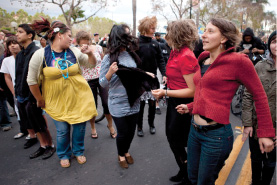
Bicyclists dance to the tunes of a live band before their monthly Bicycle Party, recently held for the first time in SoFA.
The anticipated crowds haven’t materialized except during special events, which are often funded by 1stACT.
“I would have been happy to have something less attractive,” Liccardo said, if Martinez and 1stACT had focused on bringing in “creative businesses.”
“Way too much time was spent discussing what a mural would look like,” he said.
“You think you put the pieces in place and people will come,” said the redevelopment agency’s Ekern. “It’s a much longer slog for getting people there. It’s a larger task than 1stACT thought it would be.”
“They discovered,” he said, “that some things are inert.”
Critics argue that the redesign of SoFA is too suburban, failing to reflect the area’s uniquely techie and edgy culture.
“They had a huge opportunity there to do something different, but settled for a generic streetscape,” said Joel Slayton, an artist, researcher and the brains behind San Jose’s international techno-art show known as Zer01. Still, he added: “Doing something is better than nothing.”
He wished 1stACT and the redevelopment agency had focused less on street decoration and more on providing incentives for new businesses to move in and provide an identity. SoFA, he said, would be enriched by shops that sell recycled products, a software company and, say, fashion designers. “Give it character,” he said. “Then let it grow.”
What’s missing from SoFA is “an economic driver,” said Denny Abrams, a SoFA consultant who turned Fourth Street in Berkeley into a destination of unique boutiques and restaurants. He blames much of SoFA’s troubles on a recalcitrant landlord’s refusal to divide vacant buildings into retail-friendly spaces.
Calthorpe, the nationally recognized urban planning expert, sees another problem: It might be difficult for San Jose to build traction around the idea that it’s the heart and soul of Silicon Valley. Stanford University, he said, was and is, though he said “the place-making idea is right on target.”
Martinez says 1stACT isn’t finished in SoFA, though there have been no new physical developments in a year. The economy, she says, hampered everything. For example, a new luxury apartment building in the shadows of SoFA, which would have brought hundreds of consumers into the area, remains vacant.
Finishing planned improvements, such as a renovated park, and continuing the funding of arts events will at some point become a “tipping point” that turns the place into a destination, she says.
SCENE FOUR
As SoFA evolves, Martinez is unbowed, convinced 1stACT can be the civic catalyst for urban and cultural improvements. Progress includes:
- Graduating two dozen multicultural arts leaders from an annual training program that teaches grant-writing and community-building skills and introduces them to national arts and corporate leaders. The goal: change the complexion of Silicon Valley arts leadership.
- Financing research showing Silicon Valley is a land of “wealthy geeks and immigrants” who value art that is “accessible, diverse, innovative and participatory.” Martinez explained, “We are a scrappy start-up culture. We might be a CEO by day and play in a band at night. You can’t rally around opera and symphony. That would be DOA.”
- Providing seed funding, with guidance from the research, to “non-Eurocentric” arts and cultural programs such as an annual band festival and a biannual event mixing arts and technology.
- Forging agreements with dozens of community leaders to seek philanthropic support for several civic and cultural projects, such as a creative center for the arts, public arts projects and a grand downtown park with sculpture gardens. (See “Creative Agenda” graphic.)
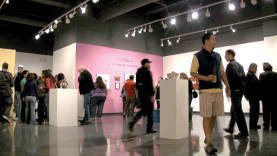
South First Friday brings an artsy crowd to SoFA on the first Friday of each month. 1stACT helped expand the event into the street.
Those agreements followed lots of groundwork. 1stACT spent its first two years doing what Martinez calls “sausage making”: researching the region, developing urban design concepts, engaging the community and coming up with an agenda that 1stACT and its supporters believe will inspire participation and philanthropy.
Last October, Martinez invited 30 foundation, corporate and individual givers to a meeting at which they discussed those and other big ideas. Several of the organizations who attended the meeting, including the Packard Foundation, Deloitte, Bank of America and Target, are contributing to the early development of several projects.
“They’re looking for the brass ring of corporate sponsors,” said the redevelopment agency’s Ekern.
Though the Knight grant is for three years, Martinez says it will take five to 10 years for 1stACT to bring its projects along, then wrap them up and turn the work over to others. Martinez says she wants to raise $25 million.
Whether she gets the money or not may depend on how donors view what 1stACT has done so far.
There’s no doubt 1stACT has raised ambition in San Jose. Though the groups most tangible project in SoFA was relatively modest, the big shift has been in the attitude at City Hall, where officials “have started to see their role differently, through the lens of what 1stACT made possible,” Knies said.
The San Jose Downtown Association’s strategic plan now recognizes downtown as a creative urban center. The redevelopment agency also adopted 1stACT’s views of downtown. Officials now routinely review projects with aesthetics and destinations in mind, Liccardo said. “But I can’t say we dropped everything to do those things,” he added. On most big projects, “we’re stuck in the mud.”
Liccardo credits 1stACT with removing bureaucratic hurdles for people who want to do something creative. “Internally there has been a raising of consciousness for the city to get out of the way,” he said.
Has 1stACT been able to create a sense of place? “No, not in the way I define sense of place,” said former board chair Chizen. “Have there been major improvements? Absolutely,” he said, pointing to SoFA, the change in ordinances and in attitude. “Is [Martinez] able to get the ball rolling on things? Yes. Are there things that would have happened anyway? Possibly. But not at the speed it happened.”
About This Series
The John S. and James L. Knight Foundation commissions independent journalists to write occasional articles reviewing its grant making and program strategies. Veteran reporters examine grant documents, conduct interviews and offer their perspective on the lessons learned and impact of Knight-supported projects in stories published online and in print. This initiative, known as the Reporter Analysis Series, began in 2006.
This report was authored by Carol Pogash, a New York Times correspondent, book author and former reporter for the San Francisco Examiner. Pulitzer Prize winning photographer Kim Komenich, who teaches multimedia at San Jose State University, produced the photography and video. The package was designed by Hiram Henriquez of H2H Graphics & Design and former Miami Herald graphics editor.
The series is edited by Judy J. Miller, who oversaw Pulitzer Prize winning coverage while managing editor of The Miami Herald. She is former president of Investigative Reporters and Editors.
For more information about the series, please visit www.knightfoundation.org.
